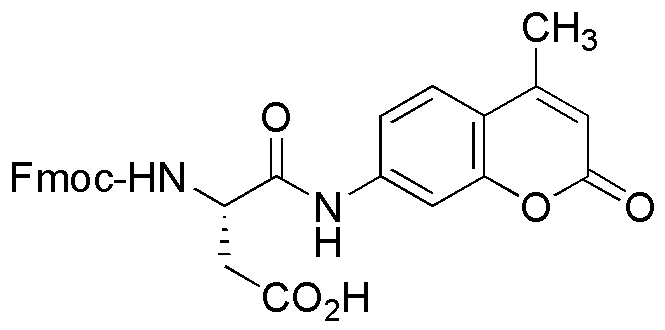Fmoc-L-Aspartic acid a-7-amido-4-methylcoumarin is widely utilized in research focused on:
- Peptide Synthesis: This compound serves as a key building block in the synthesis of peptides, particularly in solid-phase peptide synthesis, allowing researchers to create complex peptide sequences efficiently.
- Fluorescent Probes: Its unique structure enables the development of fluorescent probes for biological imaging, helping scientists visualize cellular processes in real-time.
- Drug Development: The compound is used in medicinal chemistry to design and evaluate new drug candidates, particularly those targeting specific biological pathways.
- Bioconjugation: It facilitates the attachment of biomolecules to surfaces or other molecules, enhancing the functionality of biosensors and drug delivery systems.
- Research in Enzyme Activity: This chemical is valuable in studying enzyme kinetics, providing insights into enzyme mechanisms and potential inhibitors.
General Information
Properties
Safety and Regulations
Applications
Fmoc-L-Aspartic acid a-7-amido-4-methylcoumarin is widely utilized in research focused on:
- Peptide Synthesis: This compound serves as a key building block in the synthesis of peptides, particularly in solid-phase peptide synthesis, allowing researchers to create complex peptide sequences efficiently.
- Fluorescent Probes: Its unique structure enables the development of fluorescent probes for biological imaging, helping scientists visualize cellular processes in real-time.
- Drug Development: The compound is used in medicinal chemistry to design and evaluate new drug candidates, particularly those targeting specific biological pathways.
- Bioconjugation: It facilitates the attachment of biomolecules to surfaces or other molecules, enhancing the functionality of biosensors and drug delivery systems.
- Research in Enzyme Activity: This chemical is valuable in studying enzyme kinetics, providing insights into enzyme mechanisms and potential inhibitors.
Documents
Safety Data Sheets (SDS)
The SDS provides comprehensive safety information on handling, storage, and disposal of the product.
Product Specification (PS)
The PS provides a comprehensive breakdown of the product’s properties, including chemical composition, physical state, purity, and storage requirements. It also details acceptable quality ranges and the product's intended applications.
Certificates of Analysis (COA)
Search for Certificates of Analysis (COA) by entering the products Lot Number. Lot and Batch Numbers can be found on a product’s label following the words ‘Lot’ or ‘Batch’.
*Catalog Number
*Lot Number
Certificates Of Origin (COO)
This COO confirms the country where the product was manufactured, and also details the materials and components used in it and whether it is derived from natural, synthetic, or other specific sources. This certificate may be required for customs, trade, and regulatory compliance.
*Catalog Number
*Lot Number
Safety Data Sheets (SDS)
The SDS provides comprehensive safety information on handling, storage, and disposal of the product.
DownloadProduct Specification (PS)
The PS provides a comprehensive breakdown of the product’s properties, including chemical composition, physical state, purity, and storage requirements. It also details acceptable quality ranges and the product's intended applications.
DownloadCertificates of Analysis (COA)
Search for Certificates of Analysis (COA) by entering the products Lot Number. Lot and Batch Numbers can be found on a product’s label following the words ‘Lot’ or ‘Batch’.
*Catalog Number
*Lot Number
Certificates Of Origin (COO)
This COO confirms the country where the product was manufactured, and also details the materials and components used in it and whether it is derived from natural, synthetic, or other specific sources. This certificate may be required for customs, trade, and regulatory compliance.


